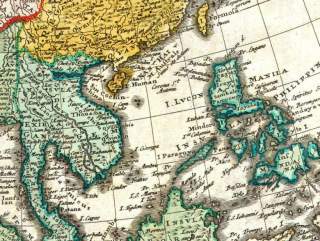South China Sea: How We Got to This Stage
Understanding the source of the tension
[v] Before 1974, all note verbales and announcements by the Vietnamese government and all Vietnamese publications and official maps recognized the Xisha and Nansha Islands as Chinese territory. For instance, on September 4, 1958, the Chinese government issued the Declaration on China’s Territorial Sea, which specified that “the Xisha and Nansha Islands are Chinese territory, and China’s sovereignty extends 12 nautical miles from their baselines”. Shortly after this, on September 14, the Democratic Republic of Vietnam President Pham Van Dong delivered a note verbale to China’s premier Zhou Enlai, to confirm Vietnam’s “recognition and acknowledgement of China’s declaration, and its “full respect” for China’s sovereignty over its territorial waters on September 14.
[vi] A. V. H. Hartendorp, History of Industry and Trade of Phillipines: the Magsaysay Administration, Manila: Philippine Education Co., 1961, p.217. See also Xiao Xiqing, A History of China-Philippines Diplomatic Relations, Taipei Academic Press, 1995, p. 831.
[vii] In July 1992, China’s then Foreign Minister Qian Qichen exchanged views with six of his counterparts from ASEAN countries at the Dialogue following the 25th ASEAN Ministerial Meeting, reaffirming China’s proposal for “setting aside dispute and pursuing joint development” and China’s intention to seek settlement of disputes with countries concerned when conditions were ripe.
[viii] ASEAN, 1998 Ha Noi Plan of Action,Ha Noi, December 15,1998.
[ix] Department of Policy Planning of the Ministry of Foreign Affairs of the People's Republic of China, China Foreign Affairs, Beijing: World Affairs Press, 2000, p. 659.
[x]Ge Hongliang. ASEAN and the South China Sea Issue, International Study Reference, Vol. 11, 2013, pp. 5-6.
[xi] ASEAN, 2002 Joint Communique of 35th ASEAN Minister Meeting, Bandar Seri Begawan , July 29-30, 2002.
[xii]Nguyen Hong Thao, “The 2002 Decalration on the Conduct of Parties in the South China Sea: A Note”, Ocean Development &International Law, 34:3-4, pp. 282-284. The Declaration on the Conduct of Parties on the South China Sea, the official website of Ministry of Foreign Affairs of the People’s Republic of China, http://www.fmprc.gov.cn/web/wjb_673085/zzjg_673183/yzs_673193/dqzz_67319..., accessed April 11, 2016.
[xiii] US Department of State Daily Briefing, May 10, 1995. http://www.state.gov/r/pa/prs/dpb/, accessed April 11, 2016.
[xiv] Speech of Hillary Rodham Clinton, Vietnam, July 23, 2010, http:/ / www.state. gov/ secretary/ rm/2010/07/145095. Htm, accessed April 11, 2016;Hillary Rodham Clinton, Hard Choices, Simon & Schuster, 2014, p.79.
[xv]The Law of the Sea of Vietnam mainly consist the following elements: first, providing for the baseline, the internal waters, the territorial sea, the contiguous zone, the exclusive economic zone, the continental shelf, islands, the Paracel and Spratly archipelagos and other archipelagos under the sovereignty, sovereign rights and jurisdiction of Vietnam; second, emphasizing that Vietnamese agencies, organizations and citizens have the responsibility to safeguard the sovereignty, sovereign rights and jurisdiction of Vietnam over its maritime zones, islands and archipelagos; third, providing that the State exercises full and absolute sovereignty over the territorial sea in conformity with the 1982 United Nations Convention on the Law of the Sea, and the baseline used for measuring the breadth of Vietnam’s territorial sea is the straight baseline already publicized by the Government. The concept of “archipelagos” which is seldom used by continental countries is specially stressed here; forth, emphasizing the development of maritime economy and expand international and regional cooperation; and fifth, clarifying the roles of the Vietnamese sea patrol and surveillance forces.
[xvi] China’s Ministry of Foreign Affairs: China’s Reclamation Efforts on Part of its Nansha Islands are Legitimate and Legal, Xinhuanet.com, April 9, 2015,
http://news.xinhuanet.com/2015-04/09/c_1114920500.htm, accessed April 11, 2016.
[xvii] In Shangri-La Dialogue held on 3 June, 2012, the US Secretary of Defense Leon Panetta officially proposed the American rebalance strategy, aiming to reinforce the US’s military presence in the Asia-Pacific region by deploying 60% of its warships to the region. His successor, Secretary of Defense Chuck Hagel, reiterated this goal on 1 June 2013, and announced the two 60% deployment, which is to deploy 60% of its warships and 60% of its overseas air force to the Asia-Pacific region by 2020.
[xviii] Speech of Daniel R. Russel, Washington. DC, February 5, 2014, http://www.state.gov/p/eap/rls/rm/2014/02/221293.htm,accessed April 11, 2016,
[xix]Jonathan W. Greenert, Chief of Naval Operations, 13 February 2014, http://www.navy.mil/navydata/people/cno/Greenert/Speech/140213%20Nationa..., accessed April 11, 2016.
[xx]The challenge of responding to maritime coercion. Retrieved from http://www.cnas.org/sites/default/files/publications-pdf/CNAS_Maritime1_..., accessed April 11, 2016.
[xxi]The US Conducts Frequent Close-in Surveillance Missions to China’s Three Major Construction Projects in the South China Sea, People's Daily, July 3, 2015. http://military.people.com.cn/n/2015/0703/c1011-27247801.html, accessed April 11, 2016.
[xxii] Xi Jinping, “Jointly Create a Better Future of Peace and Prosperity for Asia Through Dialogues and Consensus”, 28 April, 2016, http://id.china-embassy.org/eng/xwdt/t1359296.htm , accessed 1 May, 2016.

